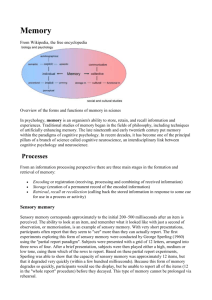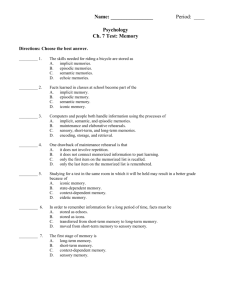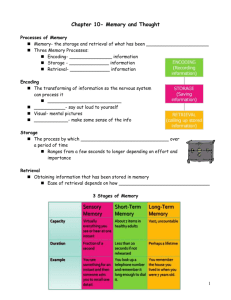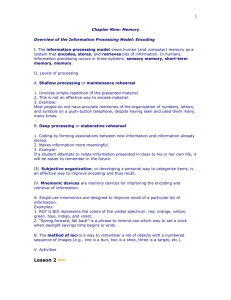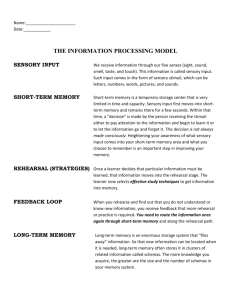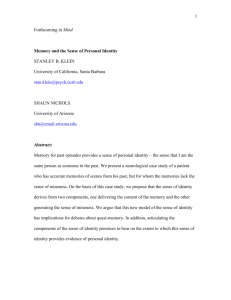SHOW
advertisement
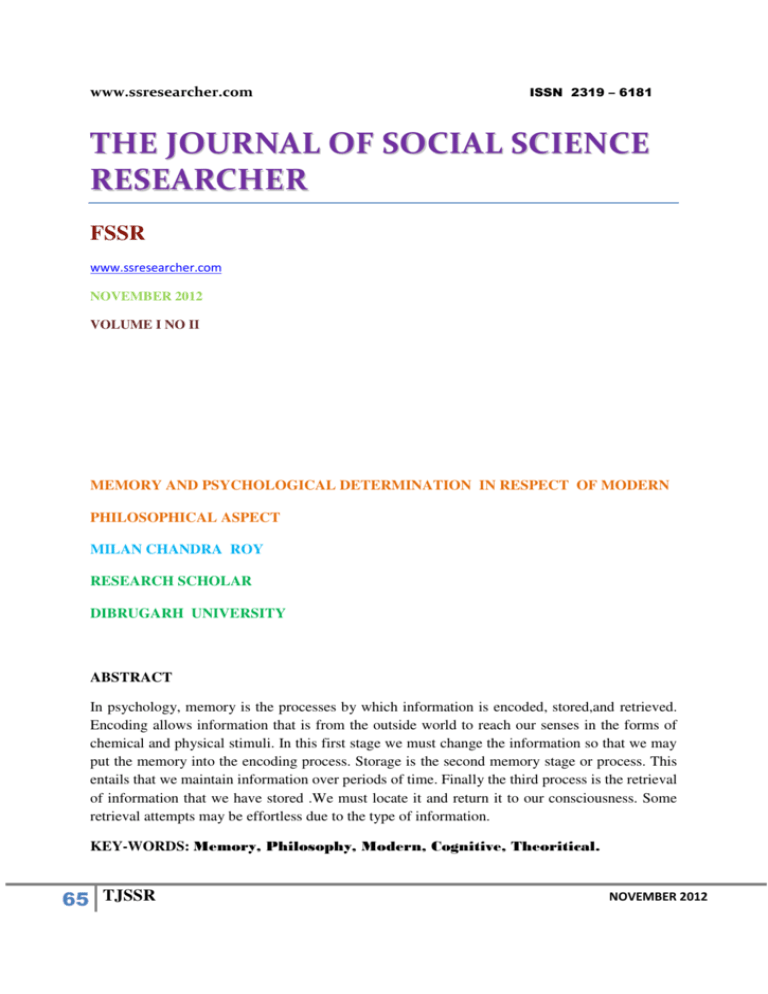
www.ssresearcher.com ISSN 2319 – 6181 T H E J O UR N A L O F S O C I A L S C I E N C E RESEARCHER FSSR www.ssresearcher.com NOVEMBER 2012 VOLUME I NO II MEMORY AND PSYCHOLOGICAL DETERMINATION IN RESPECT OF MODERN PHILOSOPHICAL ASPECT MILAN CHANDRA ROY RESEARCH SCHOLAR DIBRUGARH UNIVERSITY ABSTRACT In psychology, memory is the processes by which information is encoded, stored,and retrieved. Encoding allows information that is from the outside world to reach our senses in the forms of chemical and physical stimuli. In this first stage we must change the information so that we may put the memory into the encoding process. Storage is the second memory stage or process. This entails that we maintain information over periods of time. Finally the third process is the retrieval of information that we have stored .We must locate it and return it to our consciousness. Some retrieval attempts may be effortless due to the type of information. KEY-WORDS: Memory, Philosophy, Modern, Cognitive, Theoritical. 65 TJSSR NOVEMBER 2012 www.ssresearcher.com ISSN 2319 – 6181 DISCUSSION From an information processing perspective there are three main stages in the formation and retrieval of memory :Encoding or registration : receiving, processing and combining of received information and Storage : creation of a permanent record of the encoded information. Retrieval, recall or recollection: calling back the stored information in response Sensory memory corresponds approximately to the initial 200-500 milliseconds after an item is perceived. The ability to look at an item, and remember what it looked like with just a second of observation, or memorization, is an example of sensory memory. With very short presentations, participants often report that they seem to “see” more than they can actually report. The first experiments exploring this form of sensory memory were conducted by George Sperling (1963) using the “partial report paradigm”. Subjects were presented with a grid of 12 letters, arranged into three rows of four. After a brief presentation, subjects were then played either a high, medium or low tone, cuing them which of the rows to report. Based on capacity of sensory memory was approximately 12 items, but that it degraded very quickly (within a few hundred milliseconds). Because this form of memory degrades so quickly, participants would see the display, but be unable to report all of the items (12 in the “whole report” procedure) before they decayed. This type of memory cannot be prolonged via rehearsal. There are many types of sensory memories. Iconic memory is a type of sensory memory that briefly stores an image which has been perceived for a small duration. Echoic memory is another type of sensory memory that briefly stores sounds which has been perceived for a small duration. Short-term memory allows recall for a period of several seconds to a minute without rehearsal. Its capacity is also very limited: George A. Miller (1956), when working at Bell Laboratories, conducted experiments showing that the store of short-term memory was 7±2 items (the title of his famous paper, “The magical number 7± 2’’).Modern estimates of the capacity of short –term memory are lower, typically of the order of4-5 items, however, memory capacity can be increased through a process called chunking. For example, in recalling a ten-digit telephone number, a person could chunk the digits into three groups: first, the area code (such as 123), then a threedigit chunk (456) and lastly a four-digit chunk (7890). This method of remembering telephone numbers is far more effective than attempting to remember a string of 10 digits; this is because we are able to chunk the information into meaningful groups of numbers. This may be reflected in some countries in the tendency to display telephone numbers as several chunks of three numbers, with the final four-number group generally broken down into two groups of two. Short-term memory is believed to rely mostly on an acoustic code for storing information, and to a lesser extent a visual code. Conrad (1964) found that test subjects had more difficulty recalling collections of letters that were acoustically similar (E,P,D). Confusion with recalling acoustically similar letters rather than visually similar letters 66 TJSSR NOVEMBER 2012 www.ssresearcher.com ISSN 2319 – 6181 implies that the letters were encoded acoustically. Conrad’s (1964) study however, deals with the encoding of written text, thus while memory of written language may rely on acoustic components, generalizations to all forms of memory cannot be made. The storage in sensory memory and short-term memory generally has a strictly limited capacity and duration, which means that information, is not retained indefinitely. By contrast, long-term memory can store much larger quantities of information for potentially unlimited duration (sometimes a whole life span). Its capacity is immeasurable large. For example, given a random seven-digit number we may remember it for only a few seconds before forgetting, suggesting it was stored in our short-term memory. On the other hand, we can remember telephone numbers for many years through repetition; this information is said to be stored in long-term memory. While short-term memory encodes information acoustically, long-term memory encodes it semantically: Baddeley (1966) discovered that after 20 minutes, test subjects had the most difficulty recalling a collection of words that had similar meanings (big, large, great, huge) long-term. Another part of long-term memory is episodic memory “which attempts to capture information such as “what” , “when” and “where”. With episodic memory individuals are able to recall specific events such as birthday parties and weddings. Short-term memory is supported by transient patterns of neuronal communication, dependent on regions of the frontal lobe (especially do so lateral prefrontal cortex) and the parietal lobe. Long-term memories, on the other hand, are maintained by more stable and permanent changes in neural connections widely spread throughout the brain. The hippocampus is essential (for learning new information) to the consolidation of information from short-term to long-term memory, although it does not seem to store information itself. Without the hippocampus, new memories are unable to be stored into long-term memory, as learned from HM after removal of his hippocampus, and there will be a very short attention span. Furthermore, it may be involved in changing neural connections for a period of three months or more after the initial learning. One of the primary functions of sleep is thought to be improving consolidation of information, as several studies have demonstrated that memory depends on getting sufficient sleep between training and test. Additionally, data obtained from neuron imaging studies have shown activation patterns in the sleeping brain which mirror those recorded during the learning of tasks from the previous day, suggesting that new memories may be solidified through such rehearsal . Research has suggested that long-term memory storage in humans may be maintained by DNA methylation, or prionsmodels of memory provide abstract representations of how memory is believed to work. Below are several models proposed over the years by various psychologists. Note that there is some controversy as to whether there are several memory structures, for example, Tarnow (2005) finds that it is likely that there is only one memory structure between 6 and 600 seconds. The multi-store model (also known as 67 TJSSR NOVEMBER 2012 www.ssresearcher.com ISSN 2319 – 6181 Atkinson- Shiffrin memory model) was first recognized in 1968 by Atkinson and Shiffrin. The multi-store model has been criticized for being too simplistic. For instance, longterm memory is believed to be actually made up of multiple subcomponents, such as episodic and procedural memory. It also proposes that rehearsal is the only mechanism by which information eventually reaches long-term storage, but evidence shows us capable of remembering things without rehearsal. The model also shows all the memory stores as being a single unit whereas research into this shows differently. For example, short-term memory can be broken up into different units such as visual information and acoustic information. Patient KF proves this. Patient KF was brain damaged and had problems with his short term memory. He had problems with things such as spoken numbers, letters and words and with significant sounds (such as doorbells and cats meowing). Other parts of short term memory were unaffected, such as visual (pictures). It also shows the sensory store as a single unit whilst we known that the sensory store is split up into several different parts such as taste, vision, and hearing. In 1974 Baddeley and Hitch proposed a working memory model which replaced the concept of general short term memory with specific, active components. In this model, working memory consists of three basic stores: the central executive, the phonological loop and the visuo-spatial sketchpad. In 2000 this model was expanded with the multimodal episodic buffer. The central executive essentially acts as attention. It channels information to the three component processes: the phonological loop, the visuo-spatial sketchpad, and the episodic buffer. The phonological loop stores auditory information by silently rehearsing sounds or words in a continuous loop: the articulatory process (for example the repetition of a telephone number over and over again). A short list of data is easier to remember. The visospatial sketchpad stores visual and spatial information. It is engaged when performing spatial tasks (such as judging distances) or visual ones (such as counting the windows on a house or imagining images). The episodic buffer is dedicated to linking information across domains to form integrated units of visual, spatial, and verbal information and chronological ordering (e.g., the memory of a story or a movie scene). The episodic buffer is also assumed to have links to long-term memory and semantically meaning. The working memory model explains many practical observations, such as why it is easier to do two different tasks (one verbal and one visual ) than two similar tasks (two visual), and the aforementioned word-length effect. However, the concept of a central executive as noted here has been criticized as inadequate and vague. Working memory is also the premise for what allows us to do everyday activities involving thought. It is the section of memory where we carry out thought processes and use them to learn and reason about topics. Researchers distinguish between recognition and recall memory. Recognition memory tasks require individuals to indicate whether they have encountered a stimulus (such as a picture or a word) before. Recall memory tasks require participants 68 TJSSR NOVEMBER 2012 www.ssresearcher.com ISSN 2319 – 6181 to retrieve previously learned information. For example, individuals might be asked to produce a series of actions they have seen before or to say a list of words they have heard before. Topographic memory involves the ability to orient oneself in space, to recognize and follow an itinerary, or to recognize familiar places.Getting lost when traveling alone is an example of the failure of topographic memory. This is often reported among elderly patients who are evaluated for dementia. The disorder could be caused by multiple impairments, including difficulties with perception, orientation, and memory. Flashbulb memories are clear episodic memories of unique and highly emotional events. Remembering where you were or what you were doing when you first heard the news of President Kennedy’s assassination or about 9/11 are examples of flashbulb memories. Anderson (1976) divides long-term memory into declarative (explicit) and procedural (implicit) memories. Declarative memory requires conscious recall, in that some conscious process must call back the information. It is sometimes called explicit memory, since it consists of information that is explicitly stored and retrieved. Declarative memory can be further sub-divided into semantic memory, which concerns facts taken independent of context: and episodic memory, which concerns information specific to a particular context, such as a time and place. Semantic memory allows the encoding of abstract knowledge about the world, such as “paris is the capital of France”. Episodic memory, on the other hand, is used for more personal memories, such as the sensations, emotions, and personal associations of a particular place or time. Autobiographical memory-memory for particular events within one’s own life- is generally viewed as either equivalent to, or a subset of, episodic memory. Visual memory is part of memory preserving some characteristics of our senses pertaining to visual memory experience. One is able to place in memory information that resembles objects, places, animals or people in short of a mental image. Visual memory can result in priming and it is assumed some kind of perceptual representational system underlies this phenomenon. CONCLUSION In contrast, procedural memory (or implicit memory is not based on the conscious recall of information, but on implicit learning. Procedural memory is primarily employed in learning motor skills and should be considered a subset of implicit memory . It is revealed when one does better in a given task due only to repetition-no new explicit memories have been formed, but one is unconsciously accessing aspects of those previous experiences. Procedural memory involved in motor learning depends on the cerebellum and basal ganglia. Memorization is a method of learning that allows an individual to recall information verbatim. Rote learning is the method most often used. Methods of memorizing things have been the subject of much discussion over the years with some writers, such as 69 TJSSR NOVEMBER 2012 www.ssresearcher.com ISSN 2319 – 6181 Cosmos Rossellius using visual alphabets. The spacing effect shows that an individual is more likely to remember a list of items when rehearsal is spaced over an extended period of time. In contrast to this is cramming which is intensive memorization in a short period of time. Also relevant is the Zeigarnik effect which states that people remember uncompleted or interrupted tasks better than completed ones. The so- called Method of loci uses spatial memory to memorize non-spatial information. REFERENCES 1. Zlonoga B, Gerber A (February 1986): A case from practice pp.171-2 2. Baddeley, .D. (2000): The episodic buffer: a new component of working memory, Trends in Cognitive Science pp.417-23 3. T.L. Brink(2008): Psychology:A Student Friendly Approach, pp120 4. Neisser U.(1982):Memory observed, San Francisco Feeman, pp.201-223 5. Anderson, J.R. (196): Language, Memory and Thought, Erlbaum, pp. 201-208 6. Fagan J.F.(1974): Infant recognition memory, The effects of length of familiarization and type of discrimination task, Child Development pp.351-356 7. Rovee-Collier C. (1999): Current Directions in Psychological Science The development of infant memory,pp.80-85 70 TJSSR NOVEMBER 2012
